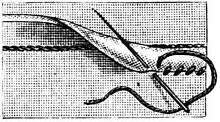seam
See also: seám
English

A flat seam in fabric
Seams of coal
Pronunciation
Etymology 1
From Middle English seem, seme, from Old English sēam (“seam”), from Proto-Germanic *saumaz (“that which is sewn”).
Noun
seam (plural seams)
- (sewing) A folded-back and stitched piece of fabric; especially, the stitching that joins two or more pieces of fabric.
- 1977, Agatha Christie, chapter 4, in An Autobiography, part II, London: Collins, →ISBN:
- Mind you, clothes were clothes in those days. […] Frills, ruffles, flounces, lace, complicated seams and gores: not only did they sweep the ground and have to be held up in one hand elegantly as you walked along, but they had little capes or coats or feather boas.
-
- A suture.
- (geology) A thin stratum, especially of an economically viable material such as coal or mineral.
- (cricket) The stitched equatorial seam of a cricket ball; the sideways movement of a ball when it bounces on the seam.
- (construction) A joint formed by mating two separate sections of materials.
- Seams can be made or sealed in a variety of ways, including adhesive bonding, hot-air welding, solvent welding, using adhesive tapes, sealant, etc.
- A line or depression left by a cut or wound; a scar; a cicatrix.
- (figuratively) A line of junction; a joint.
- (Can we date this quote?) Joseph Addison
- Precepts should be so finely wrought together […] that no coarse seam may discover where they join.
- (Can we date this quote?) Joseph Addison
Derived terms
Translations
folded back and stitched piece of fabric
|
suture
thin stratum of mineral
stitched seam of a cricket ball
a joint formed by mating two separate sections of a material
a line or depression left by a cut or wound
- The translations below need to be checked and inserted above into the appropriate translation tables, removing any numbers. Numbers do not necessarily match those in definitions. See instructions at Wiktionary:Entry layout#Translations.
Etymology 2
From the noun seam.
Verb
seam (third-person singular simple present seams, present participle seaming, simple past and past participle seamed)
- To put together with a seam.
- To make the appearance of a seam in, as in knitting a stocking; hence, to knit with a certain stitch, like that in such knitting.
- To mark with a seam or line; to scar.
- (Can we date this quote?) Alexander Pope
- Seamed o'er with wounds which his own sabre gave.
- (Can we date this quote?) Alexander Pope
- To crack open along a seam.
- (Can we date this quote?) L. Wallace
- Later their lips began to parch and seam.
- (Can we date this quote?) L. Wallace
- (cricket) Of the ball, to move sideways after bouncing on the seam.
- (cricket) Of a bowler, to make the ball move thus.
Quotations
- Henry Wadsworth Longfellow, The Skeleton in Armor:
- Thus, seamed with many scars, / Bursting these prison bars, / Up to its native stars / My soul ascended!
Etymology 3
From Old English sēam (“a burden”), from Latin sagma (“saddle”).
Noun
seam (plural seams)
- (historical) An old English measure of grain, containing eight bushels.
- (historical) An old English measure of glass, containing twenty-four weys of five pounds, or 120 pounds.
- 1952, L. F. Salzman, Building in England, p. 175.
- As white glass was 6s. the 'seam', containing 24 'weys' (pise, or pondera) of 5 lb., and 2½ lb. was reckoned sufficient to make one foot of glazing, the cost of glass would be 1½d. leaving 2½d. for labour.
- 1952, L. F. Salzman, Building in England, p. 175.
Etymology 4
You can help Wiktionary by providing a proper etymology.
Noun
seam (plural seams)
Further reading


Old English
Etymology
From Proto-Germanic *saumaz.
Pronunciation
- IPA(key): /sæːɑ̯m/
Declension
Declension of seam (strong a-stem)
| Case | Singular | Plural |
|---|---|---|
| nominative | sēam | sēamas |
| accusative | sēam | sēamas |
| genitive | sēames | sēama |
| dative | sēame | sēamum |
This article is issued from
Wiktionary.
The text is licensed under Creative
Commons - Attribution - Sharealike.
Additional terms may apply for the media files.